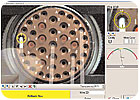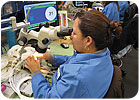
Populating multiwire connectors for military or aerospace applications can be daunting. For example, consider the Amphenol MIL-DTL-38999 connector, which can have as many as 128 sockets in a space less than 3 inches in diameter. Inserting 128 wires, pins or seals into their matching cavities without any opens, shorts or miswires takes considerable skill and time.
Fortunately, several unique technologies are available to error-proof connector assembly. Using lamps, lasers and real-time video, these products guide assemblers step-by-step through the assembly process, guaranteeing correct insertion.

AirBorn Inc. uses 17 Light Director units on two assembly lines at its Georgetown, TX, plant. Photo courtesy Bruce Rose
Lights, Cavities, Assemble
Introduced by CAMI Research in April 2008, the Light Director system uses optical fibers driven by super-bright LED lamps to individually illuminate target cavities in the connector being assembled. The Light Director is an accessory for the company’s CableEye PC-based cable-test system.Customers must purchase a mounting kit that contains a CableEye plug-in board with LED sockets that attach to the tester, fiber guide boards, a connector support board and hardware kit. All parts are reusable.
The connector being assembled is attached to a mating connector in which all positions have been fitted with optical fibers. If plugs are required in specific cavities, they are illuminated and stay lit until filled.
Before a wire can be inserted, its code must be entered into the computer by the assembler. The Light Director then announces the pin number in English or Spanish. The appropriate optical fiber is turned on, causing a bright, flashing light to project from inside the target cavity. Correct insertion is confirmed by the elimination of light from that location; insertion into an incorrect location leaves the flashing light visible.
“The system helps us significantly reduce our miswires,” says Linda Crites, a manufacturing engineer at AirBorn Inc. in Georgetown, TX. “It helps increase throughput and reduce our direct labor hours per unit.”
This AirBorn facility manufactures specialty connectors for the aerospace, industrial, medical, automotive, gas and oil industries and the U.S. military. Their prime customers include Raytheon, Northrop Grumman, Lockheed Martin, BAE Systems Inc. and DRS Technologies Inc. Products that use these connectors include the fuse link for the Patriot missile and space suits for astronauts.
AirBorn began using its first Light Director system in July 2010, then purchased 16 additional units over the next six months. The 17 units are used on two assembly lines, with 25 assemblers using them each day.
“We plan to purchase 76 more units for this facility alone,” says Crites. “Plus, our facilities in Pennsylvania, Arizona and the U.K. will order some as well. The benefits they offer make them too good not to have.”

A Boeing employee uses the HarnessMate to insert wires into a connector and build a 200-wire branch of a wire harness. Photo courtesy Boeing Corp.
Laser Precision
Several years ago, engineers from Boeing Corp.’s manufacturing, research and development group began work on a guided connector-assembly system. The product Boeing patented, and Chad Industries Inc. brought to market in March 2006, was the HarnessMate-which points a laser dot at the correct cavity for error-free insertion of wires, pins or seal plugs.Mechanically, the HarnessMate’s key component is a universal chuck that accurately positions any round connector 5/8 inch to 3 inches wide within a 16-square-inch working area. Rectangular connectors can also be handled.
Software is the other main component. It features a user-programmable database large enough to store information on as many connector assemblies as the customer wants. The software also provides a visual representation of the connector and controls the laser pointer that indicates where plugs, pins or wires should be inserted.
After selecting a connector assembly from the database, the assembler secures the proper connector in the chuck. Next, he enters label information for the wire into the computer via bar code, optical character recognition or direct keyboard input.
In response, the software references the corresponding database and directs a laser dot at the specific cavity where the wire is to be inserted. The assembler makes the insertion, and the process repeats for each wire.
The HarnessMate provides the flexibility to assemble entire harnesses without tool changes, but does not provide electronic verification.
Boeing uses the HarnessMate extensively. Nearly 60 assemblers share 25 machines at Boeing’s strategic electrical fabrication center, which is located within the company’s Mesa, AZ, plant. The center builds wire harnesses for the AH-64D Apache Helicopter and several other aircraft. Also manufactured there are the A160T Hummingbird unmanned aircraft and AH-6i light attack helicopter.
“One of the biggest problems in harness building is cross-wiring individual wires in the connector pin locations,” says Stephen Doyle, senior materials processes and physics engineer for Boeing. “This device eliminates cross-wiring, which requires rework and adds cost. The device provides a first-time quality wire insertion for all electrical connectors, and reduces wire harness build times.”
Real-Time Assembly
Another take on guided connector assembly is Pin-Sight, which Cirris Systems Corp. brought to market in 2009. The computer-based product comes with CCD camera, mounting vice, force and sense gauge, and software. A barcode scanner and mini keyboard are optional to input wire IDs.Circular, square or rectangle connectors up to 3.5 by 3.5 inches can be used. An adapter for larger connectors lets assemblers expand the working area horizontally. No mating connectors or wired mating interface is required, resulting in short set up and changeover times.
After turning on the unit’s computer, the assembler locks the connector into place and aligns it using two target cavities as specified by the software. The camera then takes a digital picture of the connector and displays a close-up image of it on the computer monitor.
Depending on the application, seal plugs might need to be inserted before terminated wires. If pins are also required, plugs and pins are programmed in groups. On the connector close-up, target circles are shown around each cavity that is to receive a plug alone or with a pin.
Before a wire can be inserted, the assembler must enter the wire’s label information into the computer by typing it on a keyboard, scanning a bar code or speaking it into a microphone. Pin-Sight then announces the wire color and cavity location, and provides, in the upper-right-hand corner of the screen, a close-up of the specific cavity where the wire should be inserted.
The assembler locates the cavity, inserts the wire and pulls back on it with enough force to ensure it is locked in. An on-screen gauge indicates the amount of force. When the contact retention is correct, Pin-Sight makes a “ding” sound. The assembler repeats the process for each wire until a tone is heard, indicating the connector is full.
To enhance accuracy, a video feed shows each plug, pin and wire being inserted in real time-even when the connector is nearly filled. By showing the video over the connector image, Pin-Sight creates a ghosting effect that lets the assembler “see through” his hand and all inserted plugs and wires.
Brent Stringham, director of global sales, says more than 100 machines are in the field. Users include Lockheed Martin, ATK Systems, L3 Communications, Embraer, Pilatus, Northrop Grumman, BAE Systems Inc. and Raytheon.

